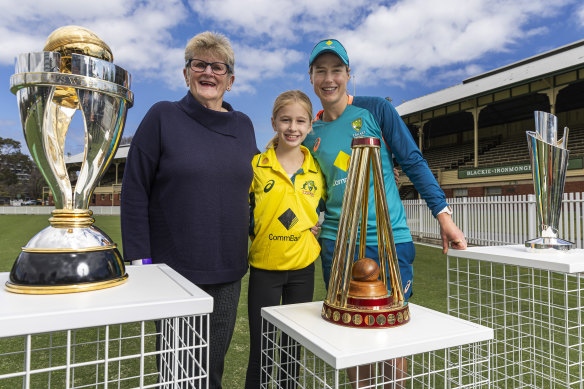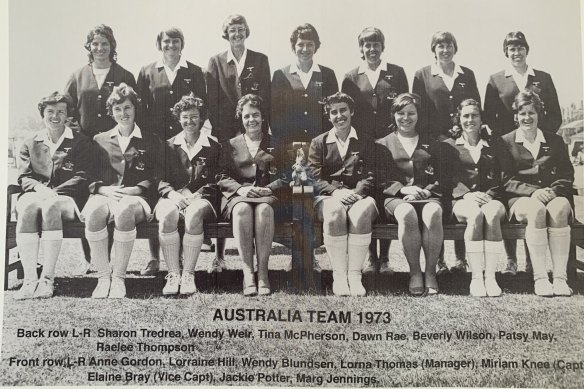This was published 1 year ago
Locked out of Lord’s: The women who blazed the trail for Australia’s dominance
By Carla Jaeger
It was 50 years ago, but former Australian cricketer Lorraine Hill still remembers exactly what she said to her teammate right before they touched down in London.
It was 1973, and the Australian team aboard that Qantas flight would soon be making history by competing in cricket’s first-ever World Cup, preceding the men’s tournament by two years.
“I was sitting next to [teammate] Raelee Thompson, and I had a tear in my eye,” the 76-year-old said. “I still remember saying to her ‘I don’t feel I belong here’. I was just so, so excited and overwhelmed by it all.”

Former Australian World Cup cricketer Margaret Jennings, junior fan Annabel Archer, and Ellyse Perry from the current Australian cricket team pose for a photograph with the ICC World Cup, Ashes and ICC T20 trophies. Credit: Getty
The conditions they faced were a far cry from the treatment that today’s stars, like Ellyse Perry, receive: The ’73 team paid their own way there, they were barred from the Lord’s pavilion, and they were responsible for scoring their own matches. Along with their airfare, the team paid for all their costs – including uniforms, shoes, and food.

Jennings was a wondrous wicketkeeper and opening batter.
Cricket hall of famer Margaret Jennings, one of Hill’s teammates for that ’73 World Cup, recalled the sparse press coverage of the tournament; “There was a little bit of hesitancy – ‘can these women play,’ you know, that sort of thing,” she said.
But it wasn’t something that bothered the players too much. They just wanted the chance to prove themselves.
“The idea that we weren’t being treated as equal didn’t, at that stage, cause us a great deal of concern. We just thought, ‘we’ve got to keep going to ensure that it continues’,” the now 74-year-old said.
Jennings later became a national selector who played a key role in Perry’s early days in Australian colours.
Perry, who has long been one of the stars of the modern era of women’s cricket, paid tribute to Jennings’ group this week. Jennings, Hill and their surviving teammates will be boundary-side watching on Thursday as Australia takes on the West Indies at the Junction Oval in the second match of their one-day international series.
“They paved the way for us,” Perry said of Jennings’ group.
“It’s wonderful - I think it’s really significant,” she said, highlighting just how far the women’s game has come since.
The history-making tournament 50 years ago was the brainchild of then-England captain Rachael Heyhoe Flint, who convinced multi-millionaire Jack Hayward to fund the 21-match round-robin tournament.
“I love cricket, I love women, why shouldn’t I sponsor women’s cricket?,” was Hayward’s reported response to Flint’s proposal.
Held across venues between June and July, seven teams participated in the competition: England, Australia, New Zealand, Jamaica, Trinidad and Tobago, Young England, and an International XI team. South Africa, in the midst of apartheid, were not invited.

The inaugural World Cup team. Pictured are: Sharon Tredrea, Wendy Weir, Tina Macpherson, Dawn Rae, Beverley Wilson, Patsy May, Raelee Thompson, Anne Gordon, Lorraine Hill, Wendy Blunsden, team manager Lorna Thomas, captain Miriam Knee, vice captain Elaine Bray, Jackie Potter, and Marg Jennings.Credit: Cricket Australia
“At the time, I don’t think we grasped the situation that we were the first to do it. I guess it was when the men, at their first one in 1975, we realised we were – in inverted commas – trailblazers,” Hill said.
“We didn’t have a coach back in those days ... We had to think for ourselves. We had to locate launderettes to do our washing.”
The women were allowed to train at Lord’s, but were outcast to the nursery, rather than being allowed in the pavilion. A headline of the women at the Home of Cricket read: “Grace turns up at Lord’s.”
Hill has kept other headlines from the tournament in a scrapbook: “Bowling the maidens over,” one paper ran. “Lords and ladies – what next? Until now a staid male bastion has fallen to women’s league,” read another.
“It wasn’t condescending, but it was getting close to being condescending,” Hill said.
In the end, the Australian side finished runner-up to England, who won by 92 runs at Edgbaston. Princess Anne was in attendance, and presented the cup to Heyhoe Flint.
The players from that era don’t despair over what could’ve been if they were able to play in the same conditions as today’s Australian team.
“You wouldn’t swap for it for quids because the enjoyment was still in it. Instead of a cool down where these kids [referring to today’s cricketers] have to go in the ice baths, we used to go have a drink at the bar,” Jennings said.
Hill feels similarly. “I would love all the training that [the players] do now, the only thing I couldn’t cope with is the ice baths.”
All the while, the professionalisation of women’s cricket happened faster than Jennings anticipated.
Her cricketing career was extensive; the Test centurion having been a World Cup winner, captain of Australia, and a long-time selector. But her greatest memory is from watching the ICC Women’s T20 World Cup final at a packed MCG.
“I remember James Sutherland [the former Cricket Australia boss] was in front of me, and turned around and said: ‘Did you ever think you’d see this Marg?’”
“I said ‘no, I often wished, but never thought it could happen.’”
Australia take on the West Indies at Junction Oval on Thursday from 10.05am.
News, results and expert analysis from the weekend of sport sent every Monday. Sign up for our Sport newsletter.